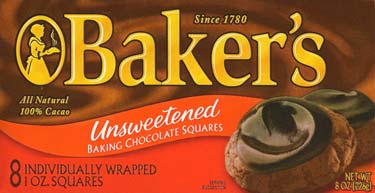| REVIEWED RECIPES |
| More popular recipes... |
| FEATURED |
| SPECIAL RECIPES |
| More featured recipes... |
| PRIZE FUDGE - COOKING SCHOOL | |
|
4 cups sugar 8 tablespoons corn syrup 1 1/2 cups water 3 or 4 squares (1 oz. ea.) unsweetened chocolate 1 teaspoon vanilla 1 cup nuts Cook all ingredients together, except nuts, to 238°F. Cool to 110°F. Beat until creamy. Add nuts, and finish by kneading the cooled batch by hand while still workable. Shape into a round roll and slice off pieces. Putting it away for at least forty-eight hours, in an air-tight container before slicing it, will improve it considerably. ABOUT FUDGE MAKING: Fudge is one of the most popular homemade candies, and one that is very often poorly made. It should be soft and creamy instead of hard and grainy. Sugar crystallization is the underlying principle of fudge making, and the formation of the crystals should be carefully controlled throughout the whole process of cooking, cooling, and beating. The only ingredients necessary for fudge are sugar, water, chocolate, and some inverting substance, such as corn syrup, cream of tartar, or vinegar. Butter and milk, though they are often added, do not improve the texture of the fudge. They contribute somewhat to the nutritional value, but sugar crystallization is not affected. That is, they do not prevent graining, and they do not add to the creamy texture of the fudge. Butter adds flavor, but the milk has a tendency to curdle, which makes the cooking more difficult as it scorches so easily when curdled. It also affects the final texture, as it is almost impossible to blend it with the remaining ingredients. The sugar and water should be thoroughly mixed, and every crystal dissolved before the boiling point is reached. Next, the remaining ingredients should be added and the solution boiled. After the boiling point is reached, it should be cooked quickly with little or no stirring. It should be stirred only when there is danger of the syrup scorching, and then, very gently. Steady boiling of the fudge mixture improves the texture, while boiling over too low a temperature makes it gummy, tasteless and imparts an "overcooked" flavor. Once the boiling point is reached, the solution becomes very sensitive to jarring, stirring, scraping, or beating, and it increases in sensitiveness as the temperature becomes higher. Jarring, stirring, and scraping start the building up of the sugar crystals along the edges of the pan, and they begin to form throughout the mass, making the final product coarse and grainy. If sugar crystals are thrown out on the sides of the pan during cooking, they should be washed off and out with a silicone brush dipped in water or a damp cloth wrapped around a fork. One undissolved sugar crystal can cause the whole batch to crystallize. When learning to make fudge, it is helpful to use an accurate Candy Making or Deep Frying thermometer. The fudge should be cooked to 238°F and allowed to cool, undisturbed, to 105°F. or at least 110°F, and then it should be rapidly converted into a creamy mass by beating. As the mass begins to thicken and lose its luster, it can either be poured out onto a buttered pan and allowed to set or it can be kneaded. Kneading makes it more creamy and smooth. Like fondant, fudge is improved by standing, and can be stored for a length of time in an airtight container for "ripening". It can be made into a long roll and rolled in nuts, and then sliced into rather large pieces. Since it keeps so well, fudge makes a wonderful gift. It isn't prone to crumbling, so it's a good choice for mailing to loved ones in far-away places during the Holidays. It isn't very well suited to being stored under warm conditions, however, and should be kept at room temperature, or below, and well wrapped. Fudge freezes well. Submitted by: CM | |
| 45 reviews | Add review Share |
SPREAD THE LOVE - SHARE THIS RECIPE | |||
| Print recipe: | Printer-friendly version | ||
| Link to recipe: | Copy | ||
| Email recipe to: | |||
Thank you for your question so that I can clarify that point.
Use unsweetened chocolate in this fudge recipe.
Have fun!
-- CM
Baker's Chocolate Squares comes in 8 oz. boxes and contains 8 individually wrapped 1 oz. squares.

Both corn syrup and vinegar will help prevent a grainy texture in fudge because they interfere with sugar's tendency to crystallize (back into its' granulated state) by breaking sucrose down into glucose and fructose components.
In candy making, this process creates lollipops that are clear and brittle and helps ensure that fudge will have a fine-grained, creamy texture.
There are many recipes and methods for making fudge. If you'd like to share your recipe, please use the "Share Your Recipe" link on the top right of the home page. We'd love to have it to share.
-- CM
If you don't have the training, knowledge, and technique... you can almost bank on disaster! Fudge is a sugar making process which when working with sugar crystallization is always at the fore front for disaster!!!
DENNIS, I am make a PB fudge from a recipe I got from cooks.com that calls for the marshmallow stuff and it is delicious and very creamy. No grainy at all.
Try adding a tablespoon of espresso powder (available at some baking supply stores) or a spoonful or so of very dark cocoa like Droste.
-- CM
If not using a thermometer, you can use these Tests.
| — REVIEW PAGE — |
| 23Next |
| ADD YOUR REVIEW |
| RECIPE PULSE |
| TRENDING NOW |
Sincerely In Christ, deb